Are you still searching gardening forums and communities for help identifying your succulent's species? You've found the right spot! Let me teach you a trick to identify succulents by the characteristics of their flowers preliminarily. If you're new to succulents, don't miss out on this blog. Join me in admiring various succulent blooms and the distinctive features of flowering succulents from different genera:
Echeveria

This succulent with bell-shaped flowers is an Echeveria. Echeverias, known for their adorable appearance and easy maintenance, have become quite popular recently. They bloom in summer, typically from June to August. Their flowers come in various colors, like pink, red, and yellow, forming a rosette flower cluster. When in full bloom, the flower buds gently open, resembling little trumpets or bells.
You may wonder: How to care for Echeverias.
Graptopetalum

This succulent with speckled star-shaped flowers belonging to the Graptopetalum genus is next up. Graptopetalum flowers typically have red-brown speckles or stripes engraved on their petal epidermal cells, beautifully illustrating the ghost plant's flower characteristics. Usually, with 5-6 petals, their flowers can fully open, presenting a star-like shape with dark speckles or stripes concentrated at the petal tips.
Pachyphytum
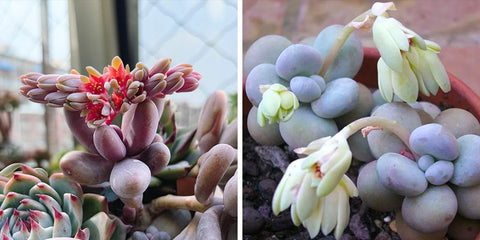
Check out these unique spike-like flowers belonging to the Pachyphytum genus. Most Pachyphytums have plump leaves and upright flower stalks. Typically, 10-20 cm below the flower stalks, there are no leaves. Pachyphytum succulents can produce over 50 flowers arranged in two rows hanging down. During flowering, the petals curve backward.
Cotyledon
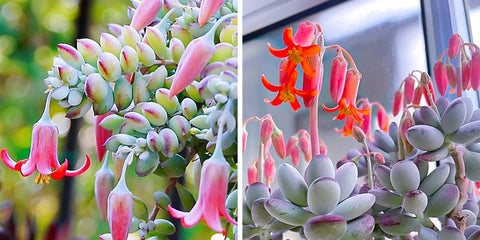
Look at the tiny flowers hanging from this Cotyledon succulent – so pretty! Cotyledon flowers are tubular and usually brightly colored in shades from red to orange, attracting pollinators' pollination. Consequently, they've produced many natural variations. Dozens of flowers hang on long flower stalks. When in bloom, the petals don't fully open; instead, the petal tips curve outward and upward, resembling little bells.
Sedum
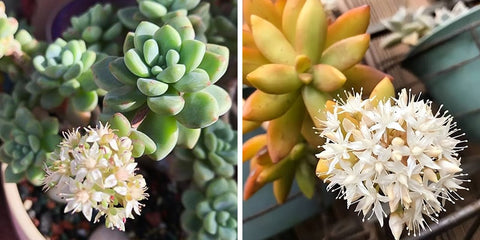
These dense little flowers would look lovely in your garden! Sedum succulents typically have clusters of flowers with five petals each, growing densely at the plant's top. Individual flowers are tiny, and upon close observation, you'll notice that the number of stamens is usually twice that of the petals. They look charming when fully open with various colors like white, yellow, red, and purple.
You may also be interested in: Top 15 Popular Sedums Can Grown as Houseplants.
Crassula
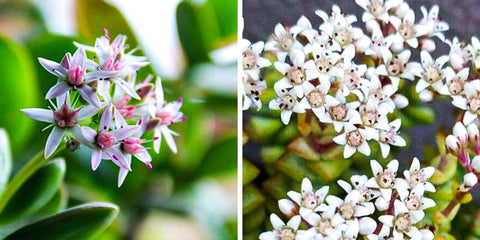
Seeing these white flowers, you might wonder, "Does Crassula also bloom?" Certainly, but they grow slowly. It takes 5-10 years for mature Crassulas to flower. Crassula flowers have 5-6 petals arranged in rosette clusters at the top, similar to Sedum flowers. The flowers are usually white or red. Unlike Sedum, Crassula leaves are typically stacked in layers, not in a rosette shape.
Adromischus
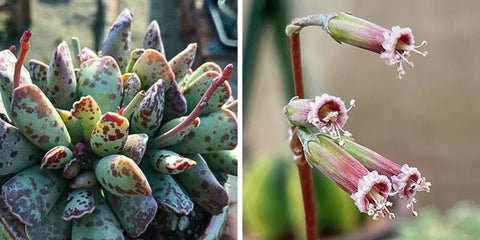
I almost missed these tubular flowers of Adromischus succulents! Adromischus flowers are tubular, alternating in arrangement on upright flower spikes. When fully open, the flower tops slightly curl downward, not very conspicuous.
You may wonder: How to Care for Adromischus Succulents.
Haworthia
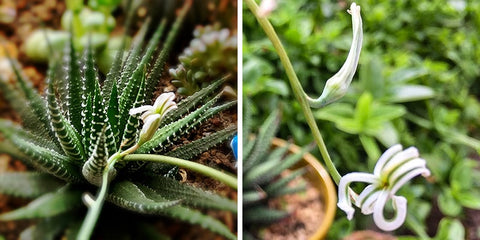
These flowers are so fabulous! Haworthia flowers are primarily white with dark vertical stripes. The flower stalks are long and upright. Before blooming, the tubular flowers resemble those of Adromischus, but the flowering range is more extensive, and some irregular twisting may occur.
You may also be interested in: Top 15 Popular Haworthia You Need to Have.
Aeonium
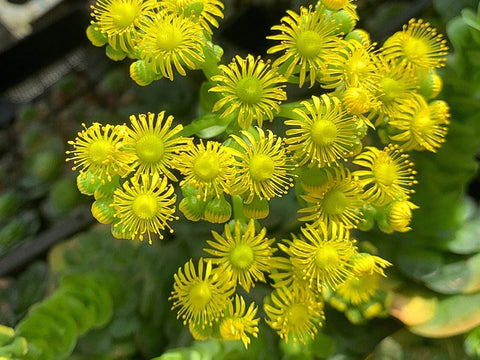
Aeonium flowering is called "death bloom" – once it blooms, the Aeonium succulent is about to die. However, successful pollination during flowering leads to new life. The yellow flowers cluster together like a tree full of flowers, resembling little daisies up close.
You may also be interested in: 15 Popular Aeonium Succulent to Grow.
Sempervivum
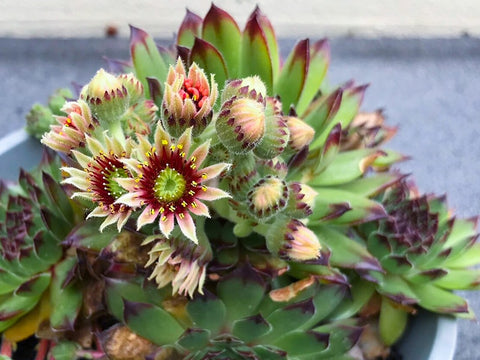
Sempervivum, like Aeonium, doesn't bloom frequently, but when it does, it signals the end of its life. With over six petals, the fully open flowers resemble stars, and the flower stalks are thick and easily recognizable. The most common colors are pink and yellow.
What to Do When Succulents Bloom?
First-time succulent bloomers, don't panic! You can take a few days to admire the flowering process. Since some succulents like Echeveria have more extended flowering periods, they may attract some small insects and scale insects. To avoid this risk, it's best to trim the flower stalks promptly, and you can continue to enjoy the collected flowers by placing them in pots.
Why Isn't My Succulent Flowering?
The main factors affecting succulent flowering are nutrition, light, and temperature. When a succulent meets all three conditions simultaneously, it will bloom.
Nutrition: This refers to the time of succulent growth and nutrient accumulation. Most succulents bloom after 1-2 years of development. If they haven't bloomed yet, consider adding some phosphorus fertilizer to the soil, as it promotes flowering.
Light: For most succulents, indirect sunlight indoors or direct sunlight outdoors is sufficient for flowering.
Temperature: Different succulents have different temperature requirements for flowering. For example, Echeveria blooms in spring to summer temperatures, while Christmas cacti bloom in winter.
If your succulent hasn't bloomed yet, consider these three factors: find the cause, provide the ideal environment, and patiently await flowering.
Enjoy the beauty of succulent blooms and happy gardening!
You may also be interested in: Top 10 Popular Blooming Succulents.

























